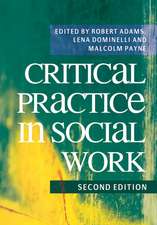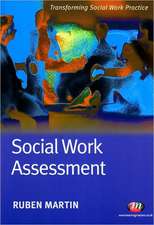Prevention Program Development and Evaluation: An Incidence Reduction, Culturally Relevant Approach
Autor Robert K. Conyneen Limba Engleză Paperback – 31 aug 2009
Interspersed throughout the book are descriptions of "everyday prevention" practices, as well as concrete prevention program examples that have been proven effective in the community where they were implemented. Conyne draws the book's contents to a close through using a set of guided questions that walk the student or practitioner through the prevention program development and evaluation process. Numerous learning exercises, figures, and a comprehensive set of references in prevention and in program development and evaluation enhance the text's attractiveness and usability.
| Toate formatele și edițiile | Preț | Express |
|---|---|---|
| Paperback (1) | 555.44 lei 6-8 săpt. | |
| SAGE Publications – 31 aug 2009 | 555.44 lei 6-8 săpt. | |
| Hardback (1) | 847.11 lei 6-8 săpt. | |
| SAGE Publications – 31 aug 2009 | 847.11 lei 6-8 săpt. |
Preț: 555.44 lei
Preț vechi: 653.46 lei
-15% Nou
Puncte Express: 833
Preț estimativ în valută:
106.30€ • 110.57$ • 87.75£
106.30€ • 110.57$ • 87.75£
Carte tipărită la comandă
Livrare economică 14-28 aprilie
Preluare comenzi: 021 569.72.76
Specificații
ISBN-13: 9781412966801
ISBN-10: 1412966809
Pagini: 232
Dimensiuni: 178 x 254 x 15 mm
Greutate: 0.41 kg
Ediția:1
Editura: SAGE Publications
Colecția Sage Publications, Inc
Locul publicării:Thousand Oaks, United States
ISBN-10: 1412966809
Pagini: 232
Dimensiuni: 178 x 254 x 15 mm
Greutate: 0.41 kg
Ediția:1
Editura: SAGE Publications
Colecția Sage Publications, Inc
Locul publicării:Thousand Oaks, United States
Cuprins
Preface
List of Tables and Figures
PART I: PREVENTION FOUNDATION
Ch 1. Prevention in Everyday Life
Ch 2. Basic Tenets of Prevention
Ch 3. Criteria for Determining a Prevention Program
Ch 4. Reducing Incidence in Prevention
PART II: PROGRAM DEVELOPMENT AND EVALUATON
Ch 5. Program Development and Evaluation : Basic Understandings
Ch 6. Community-Based, Collaborative, Culturally Relevant PD&E
PART III: TEN-STEP PREVENTION PROGRAM DEVELOPMENT AND EVALUATION APPROACH
CH 7. Laying the Groundwork for Community, Collaboration, and Cultural Relevance Processes: Steps 1-8
Ch 8. Designing the Prevention Program and Evaluation Plan: Steps 9-10
Ch 9. Back to the Future: Applying Incidence Reduction to Problem Identification in Prevention Program Development and Evaluation
Ch 10. Analyzing and Learning From Prevention Programs
Appendix A: Ten-Step PPD&E Model
Appendix B: Laying the Groundwork (Steps 1-8) for Community, Collaboration, and Cultural Relevance
Appendix C: Implement and Evaluate (Steps 9-10)
Appendix D: PPD&E Step 9: Design the Prevention Program Plan
Appendix E: PPD&E Step 10: Design the Prevention Program Evaluation Plan
Appendix F. Basic Incidence Reduction Formulae
Appendix G. PPD&E Step 9b: Identify the Problem
Appendix H: Useful Web Sites
References
List of Tables and Figures
PART I: PREVENTION FOUNDATION
Ch 1. Prevention in Everyday Life
Ch 2. Basic Tenets of Prevention
Ch 3. Criteria for Determining a Prevention Program
Ch 4. Reducing Incidence in Prevention
PART II: PROGRAM DEVELOPMENT AND EVALUATON
Ch 5. Program Development and Evaluation : Basic Understandings
Ch 6. Community-Based, Collaborative, Culturally Relevant PD&E
PART III: TEN-STEP PREVENTION PROGRAM DEVELOPMENT AND EVALUATION APPROACH
CH 7. Laying the Groundwork for Community, Collaboration, and Cultural Relevance Processes: Steps 1-8
Ch 8. Designing the Prevention Program and Evaluation Plan: Steps 9-10
Ch 9. Back to the Future: Applying Incidence Reduction to Problem Identification in Prevention Program Development and Evaluation
Ch 10. Analyzing and Learning From Prevention Programs
Appendix A: Ten-Step PPD&E Model
Appendix B: Laying the Groundwork (Steps 1-8) for Community, Collaboration, and Cultural Relevance
Appendix C: Implement and Evaluate (Steps 9-10)
Appendix D: PPD&E Step 9: Design the Prevention Program Plan
Appendix E: PPD&E Step 10: Design the Prevention Program Evaluation Plan
Appendix F. Basic Incidence Reduction Formulae
Appendix G. PPD&E Step 9b: Identify the Problem
Appendix H: Useful Web Sites
References
Notă biografică
Robert K. Conyne, Ph.D., William A. Allen Boeing Endowed Chair & Distinguished Professor, Seattle University, 2013-14 and Professor Emeritus from the University of Cincinnati, is a licensed psychologist, clinical counselor, and fellow of the Association for Specialists in Group Work (ASGW) and the American Psychological Association. He has amassed 42 years of professional experience as a university professor and department head, counselor, administrator, consultant, and trainer, and, most recently, as a consultant to military personnel and their families at U.S. installations both at home and overseas. Bob has received many awards, including Eminent Career Award from the ASGW; Lifetime Achievement Award in Prevention, Society of Counseling Psychology of the APA; Distinguished Alumni Award of Distinction from Purdue University; and has been designated a Soros International Scholar. He was the 2009 president of the APA¿s Division of Group Psychology and Group Psychotherapy, and in 1996 was president of the Association for Specialists in Group Work. With over 200 scholarly publications and presentations including 14 books in his areas of expertise (group work, prevention, and ecological counseling), along with broad international consultation in these areas, Bob is recognized as an expert in working with people and systems. With colleague (and wife), Lynn S. Rapin, Ph.D., he also helps people plan and prepare psychologically for their upcoming retirement, using the holistic approach they developed, "Charting Your Personal Future." His most recent publication is the Prevention Practice Kit, co-edited with Arthur M. Horne, Ph.D., immediately preceded by the Handbook of Group Counseling (edited, Oxford University Press, 2011). Forthcoming is the Group Work Practice Kit (edited, Sage). In all these edited books, Bob also authored contributions.
Descriere
This book covers preventive counseling and guides the reader on how to use such a model to prevent mental health issues occuring













